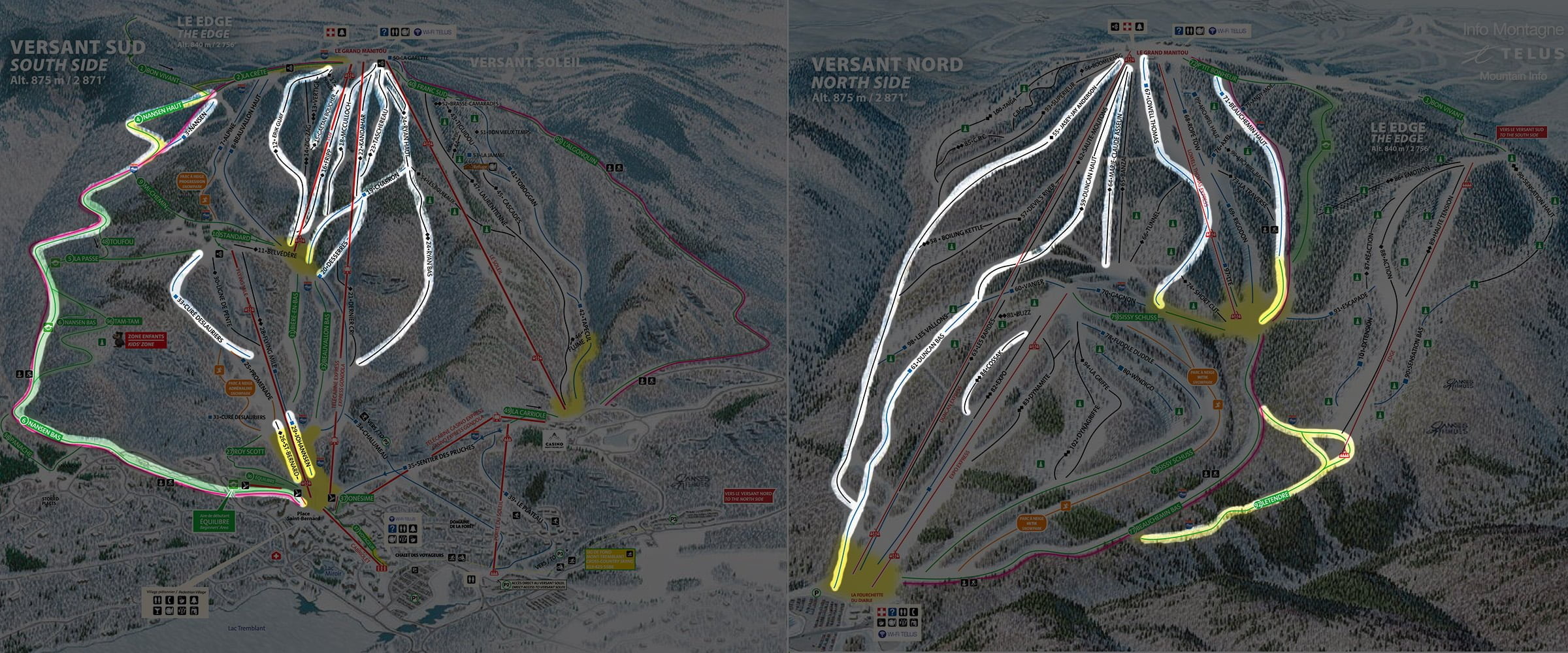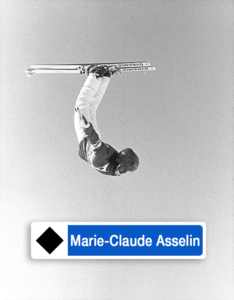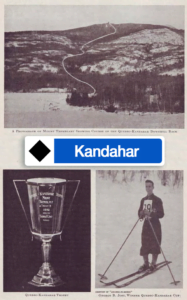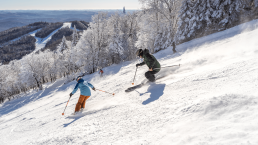If ski runs could talk, they would have a lot to tell about the events and especially the passionate people who have marked the history of Tremblant since its opening in 1939. Over the years, we have honored these personalities and athletes in many ways, including giving them the name of one of our ski runs.
We hope you enjoy their stories:
HISTORICAL FIGURES
CURÉ DESLAURIERS (blue South)
Father Charles-Hector Deslauriers was appointed founding priest of Mont-Tremblant on July 21, 1929, just before the Great Depression. Upon his arrival, he was noticed for his dedication, his dynamism and his involvement in the community. He soon realized that the lumber industry was not enough to revive the economy of the region and when he met Joe and Mary Ryan, he saw an opportunity for his parish. Father Deslauriers was an important link between the residents of the village and the tourists. A bridge between the village and the mountain.
The tradition was that at the beginning of each winter, the girls and the boys went to the chapel to have their skis blessed, and the priest made sure that no one was missing. He also organized, a few times a season, ski days for the children of the village. The slope was first named Sir Edward Beatty, in honor of the Canadian Pacific Railway president at the begining of the 1900s.
RYAN (double-diamond South)
Following an expedition to the summit of Mont Tremblant in 1938, Joseph “Joe” Bondurant Ryan founded Mont Tremblant Lodge, inaugurated in February 1939. Go-getter and daring, the American millionaire and his wife Mary imagined a ski resort using the latest technology of the time with regards to ski lifts. The creation of Mont Tremblant Lodge injected much needed vigor into the local economy and built the region’s reputation on the North American continent. After her husband’s death, Mary Ryan ran the station until 1965.
LOWELL THOMAS (blue North)
A member of this same expedition to the top of the mountain in 1938 with Joe Ryan and Harry Wheeler, Lowell Thomas returned regularly to Mont-Tremblant. There, he broadcast his radio newscasts live to the United States, thus contributing to the North American notoriety of the station and the resort.
NANSEN (green South)
This magnificent 6km green trail is named for Fridtjof Nansen, a great Norwegian explorer and the first man to cross Greenland in 1888. He was also the recipient of the Nobel Peace Prize in 1922. His son, Kare Nansen, who also loved to ski, was hired by Joe Ryan to oversee the construction of the resort and manage the inn.
JOHANNSEN (blue South)
The Nansen trail was blazed by another Canadian ski legend, Hermann “Jackrabbit” Smith-Johannsen. The Norwegian by origin and Quebecer by adoption, was the first major promoter of skiing in the Laurentians and in other areas.
FRIPP (diamond South)
A burly and athletic veteran of the Second World War, John Fripp became the first non-European to run a major ski school in North America from 1945 to 1948. Winner of several renowned races, including the grueling Quebec- Kandahar event, Joe Ryan chose this Canadian candidate because he was impressed with his speed on skis! Following his years at the head of the Tremblant ski school, he then played two seasons in the CFL with the Ottawa Rough Riders. This accomplished athlete turned 101 this year!
MCCULLOCH (diamond South)
Winner of virtually every major alpine title in Canada and the United States, Ernie McCulloch was elected Skier of the Half-Century in 1950. Affectionately known as the “King of Mont Tremblant”, he became director of the Tremblant ski school. in 1950 and remained there until 1969.
DUNCAN (blue / diamond North)
Born in Saint-Jovite on August 31, 1918, Charles “Charlie” Duncan was part of the first team of instructors of the Alliance of Canadian Ski Instructors (CSIA), then he became director of the ski school of Mont Tremblant. Upon his return from World War II in 1945, he became a station administrator. The Duncan trail is therefore in honor of this man, an emblematic figure of skiing at Tremblant and a native of the region.
Another fact about Charlie Duncan: his son Peter Duncan was a member of the Canadian alpine ski team from 1960 to 1971, American champion in 1965 and participated in the 1964 and 1968 Olympic Games. TV commentator, columnist at Tremblant Express and involved citizen, Peter loves to tell his story about the development of the Mont Tremblant ski resort.
BEAUCHEMIN (blue/green North), CHARRON (blue South) & DESSERRES (blue South)
The Beauchemin, Charron and Desserres trails represent three of the four owners of Station Mont Tremblant from 1965 to 1979, Roger Beauchemin, André Charron and Roger DeSerres. The Beauchemin and Charron slopes were named Habitant and Mi-Chemin when the resort first opened.
In the jargon of mountain operators, the last “pitch” of the Duncan trail is called “pitch Levesque” in honor of Jean-Louis Levesque, the station’s fourth owner during those years.
LETENDRE (green North)
The Letendre family has long maintained an important presence in the Mont-Tremblant municipality. The Letendre trail is therefore named in honor of the Letendre brothers, Alexandre, Paul and René, who for a long time owned the general store at Lac Mercier, in the old village of Tremblant. Today, you can find there the Sandwicherie.
In the back of the store was also a snack-bar style restaurant, operated by Anette, Paul’s wife. She installed the only television in the village, thus allowing the villagers to watch sports events among other things, making the Letendre family one of the pioneers of sports restaurants in the region.
TASCHEREAU (diamond South)
Named in honor of the 14th Prime Minister of Quebec, Louis-Alexandre Taschereau, it was among the first 13 ski runs on Mont Tremblant in the late 1930s. It was in an effort by the Club de ski de St-Jovite to involve young people in skiing and develop a competitive element in the region, that Taschereau raised funds to create the track and name it. He also had a lot of support from Father Deslauriers in this initiative. It is also from there that the Taschereau ski race was created, in honor of his important role and his involvement in the project.
Fun fact, the track was named in 1936, two years before the official opening of the station by Joe Ryan in 1938.
ROY SCOTT (green South)
Roy Scott is a former mountain operations manager in the 90s, who died in a tragic car accident while leaving work one evening. Tremblant renamed the trail after him in his memory.
KANDAHAR (diamond South)
This black run is named after the Coupe Québec Kandahar, a series of races dating back to 1928 that was started by the British club Kandahar Ski Club. The club itself was named for Field Marshal Earl Roberts of Kandahar, a Victorian British general who was an early supporter and donor to alpine ski racing.
ST-BERNARD (diamond South)
A priest originally from Savoy, Bernard de Menthon built a monastery in one of the highest and most dangerous passages in the Alps. It was in this monastery that the Saint-Bernard, a famous breed of alpine dog, developed which accompanied the monks in their operations to rescue pilgrims who used these peaks.
FLYING MILE (diamond South)
The Tremblant World Cup trail was named after Joe Ryan’s horse. Being a great fan of horse racing, Joe Ryan saw the potential of the resort for skiing competition when he first started the project of its creation back in 1939. The first alpine skiing World Cup was held in the Flying Mile trail in 1983 for the Women’s World Cup in giant slalom, and now the race is back at Tremblant after 40 years on that same trail.
ATHLETES
MARIE-CLAUDE ASSELIN (diamond North)
Triple world champion, the achievements of Marie-Claude Asselin, combined with her dynamic personality and enthusiasm, have made her a source of inspiration for those around her. She competed from 1977 to 1982 in the aerial freestyle, ballet and mogul categories, winning 35 Freestyle Skiing World Cup competitions.
JASEY-JAY ANDERSON (diamond North)
A resident of the Mont-Tremblant region, Jasey-Jay Anderson is the most decorated Canadian snowboarder in history, having dominated his sport for nearly 10 years. He has three World Championships as well as a gold medal obtained at the Vancouver Olympics in 2010. Anderson has also represented Canada at six Olympic Games including: Nagano (1998), Salt Lake (2002), Turin (2006), Vancouver (2010), Sochi (2014) and PyeongChang (2018). The slope was first named Géant before changing its name in 2010.
ERIK GUAY (diamond South)
A seasoned competitor from the Mont Tremblant region, Erik Guay was one of the greatest alpine skiers in Canadian history. Super-G world champion in 2017, his record on the World Cup circuit includes 25 podiums, including 5 wins. To date, he is the most decorated alpine skier in the country! His name replaced the Grand Prix slope in 2010 during the resort’s 75th anniversary.
GAÉTAN BOUCHER (diamond South)
One of the greatest Quebec athletes of all time, Gaétan Boucher was an extraordinary speed skater. His accomplishments include winning a silver medal at the Olympic Games in Lake Placid in 1980 and two gold medals in Sarajevo in 1984.
COSSAK (double-diamond North)
The Cossak, a mogul run on the north side that was used for the World Cup, was named for the maneuver (cossak) made popular by the pioneer of mogul skiers, Jean-Luc Brassard.

Other runs represent Tremblant through its Native American and Quebec roots, expressions, or others. Here are some memorable track names.
NATIVE AMERICAN & QUEBEC FOLKLORE
ALGONQUIN (green Soleil)
Named for the Native American community that occupied the territory of Tremblant for several centuries.
TOBOGGAN (blue Soleil)
A word of Algonquian origin, a toboggan is a flat snow sled, without runners, whose front is curved to facilitate sliding. Native Americans used it for winter transportation.
TAM-TAM (green South)
A commonly used term for various kinds of membranophones (drums) of Native American origin.
WINDIGO (blue North)
This is a supernatural being who belongs to the spiritual tradition of the Algonquian-speaking First Nations.
RIGODON (blue North)
Rigodons are folk songs and dances originating in France and passed through the province of Quebec at the time of the colonization of New France. Popularized during religious festivals in the villages, the music is produced with traditional instruments such as wooden spoons, the harmonica, or the violin.
CHALUMEAU (blue South)
Pipe-shaped part used to extract sugar maple sap. It is composed of one end that is pushed into the tree after having cut it and another in the shape of a tap under which a bucket is hung to collect the maple sap.
EXPO (double-diamond/blue North)
Named in honour of the Montreal Expo 67, this mid-mountain trail on the North side is a mogul steep trail under the ski lift of the same name.
EXPRESSIONS
FUDDLE-DUDDLE (blue North)
This trail name is a nod to the sentence uttered by Pierre Elliott Trudeau in the House of Commons, suspected of having sent off a member of an opposition party. He caught himself saying “fuddle duddle”!
BIÈRE-EN-BAS (green South)
Beautiful easy run, often the last run of the day… perfect for après-ski!
BRASSE-CAMARADE (double-diamond Soleil)
This expression is mainly used in Quebec to designate a commotion, either an agitation or confusion.
OLD TRAILS WITH HISTORICAL NAMES
HANS FALKNER (South Side)
Now La Crête slope t the top of the mountain, it was first named in honor of the first Tremblant ski school director. The Austrian Hans Falkner took over the management of the school in 1939, before passing the torch to John Fripp in 1945.
PÈRE DESLAURIERS (South Side)
The slope was renamed La Passe in 1973 and is still on today’s trail map (it is the trail allowing us to cross the Nansen Bas from the top of the Flying Mile lift). This name still exist on the mountain under the slope name Curé-Deslauriers on the South Side.
A big thanks to every one who collaborated to the creation of this article.









